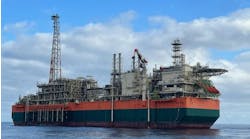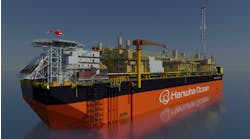GULF OF MEXICO: As US Gulf discoveries move doun the slope, will deepwater reserve additions continue?
The number, size distribution, and hydrocarbon type of deepwater discov-eries will have profound implications for US oil and gas supplies during the next 10-20 years. If oil discoveries in deepwater can continue at recent rates for the next several years, they will be sufficient to reverse the decline since 1985 in domestic oil production.
Unless more large and giant gas discoveries are made in deepwater, the deepwater area will not be the predominant component of increasing domestic gas production it has been projected to be.
Through 2000, depending on how much recent deepwater discoveries will grow once they begin production, approximately 10-12 billion bbl of crude oil have been discovered in the deepwater Gulf of Mexico. More than half of this amount was discovered in the past three years.
If crude oil discoveries in the deepwater occur at a rate of 1-1.25 billion bbl per year through 2005, a rate 65-70% of the 1998-2000 average, by 2008-2010, crude oil production from deepwater will reach levels of 3-3.5 million b/d. Coupled with a slow increase in natural gas liquids (NGL) production, a stabilization in Alaskan crude production, and a slightly accelerating decline in the rest of domestic crude production, the increase in deepwater crude oil production will be sufficient to increase total domestic oil production from 7.75 million b/d in 2000 to 9.25-9.5 million b/d in 2008-2010.
The major uncertainty here is whether such a rate of reserve additions can continue. The number and potential size of prospects in the East Breaks, Garden Banks, Green Canyon, and Mississippi Canyon deepwater lease areas seems sufficient for this rate to continue through 2003.
If substantial additions are to continue past 2003, there will need to be giant and large discoveries in the Atwater Valley, Keathley Canyon, and Walker Ridge deepwater lease areas as well. Other than two Atwater Valley discoveries, exploration in these three deepwater lease areas has not yet been successful.
The big question is thus whether the relatively few failures in these lease areas are predominantly local (faulty seals, inadequate migration paths) or indicate regional problems (mainly a lack of hydrocarbon charge resulting from insufficient thermal maturity of the Jurassic source rock).
Gas supply implications
The future of deepwater gas production is nowhere near as bright. Through 2000, approximately 28-35 tcf of gas has been discovered in the deepwater lease areas. But only about 1.8-2.4 tcf was discovered in 2000, with no more than 300 bcf of this amount being non-associated gas.
If the only gas discoveries made in deepwater in the future are small and medium size fields (essentially 30-300 bcf fields), deepwater gas production is unlikely to ever even double its 2000 total of 1.4 tcf/year. With the continuing decline in shelf production, this, at best, means only a slow increase in overall Gulf of Mexico gas production through 2005.
During the later half of this decade, overall Gulf of Mexico gas production will subsequently decline. The growing casinghead gas production deepwater will prove insufficient to counteract increasing declines in non-associated gas prod-uction both on the shelf and deepwater.
Strong discovery rate
Deepwater discoveries in 2000 fell back from the torrid pace set in 1999. Despite this moderate decline, 2000 was still the second best year for deepwater discoveries, both in terms of the number of new field discoveries and the amounts discovered.
This overview of 2000 deepwater discoveries is based on a thorough review of the MMS (US Minerals Management Service) borehole data, the latest MMS master field list, the offshore industry trade press, and corporate press releases and reports.
For a well to be classified as a new field discovery, its drilling must have been completed in 2000, it must not be an extension to an existing field, and its status as a discovery must be confirmed either by an operator announcement or by inclusion in the MMS master field list.
The definition of deepwater as defined by water depth has changed considerably over the past 15 years as deepwater exploration and production technology has progressed. To avoid ambiguity and to maintain continuity of comparisons, "deepwater" in this review means all the deepwater lease areas in the Gulf of Mexico OCS.
All available information to date indicates 21 new field discoveries in the deepwater Gulf of Mexico in 2000 (see list). These discoveries were highly concentrated in a swath across the Garden Banks, Green Canyon, Ewing Bank, Mississippi Canyon, and Viosca Knoll lease areas. This number was both significantly less than the 1999 peak of 30 new field discoveries and significantly more than the 18 in 1997 and the 16 in 1998. The 2000 total was exactly the average of the past four years, more than four times the average of five deepwater discoveries per year from 1981 through 1995. More than half of the 182 discoveries in the deepwater lease areas have been made in the past five years.
In evaluating new field discoveries, the size of discoveries always matters more than their number. In this respect, 2000 was also the second best year on record. During the past year, one large giant field (Crazy Horse North) and at least four small giant fields (Entrada, Front Runner, Gunnison, and Princess) were discovered. At its discovery, Marco Polo was indicated as a likely small giant; however, its disappointing appraisal wells above the salt have revised this assessment downward.
Only 1999, with one large giant and eight small giant discoveries, exceeds 2000. The giant discoveries in 2000 are nearly equal in number to those in 1996 through 1998 combined. Because of the five giant discoveries deepwater in 2000, an estimated 1.75 billion BOE was discovered this past year. Again, this is second only to the 3.6 billion BOE discovered in 1999. These estimates are highly preliminary, subject to an uncertainty of at least ±25%. But they provide a reliable basis for relative order of magnitude comparisons. During the past three years nearly 7 billion BOE has been discovered in the Gulf of Mexico deepwater lease areas.
Deepwater trends
Deepwater discoveries in 2000 continued several trends that have emerged in the deepwater lease areas during the past several years:
- First of all, 2000 deepwater discoveries were predominantly oil fields (76%). During the past five years, 57% of all deepwater discoveries were oil fields. During the past three years, 70% of all discoveries have been oil fields. The increasing predominance of oil discoveries in deepwater is even more pronounced when one considers discoveries by size class. During the past five years, 90% of the giant fields discovered in the deepwater were oil fields. At the other end of the size spectrum, 100% of all small fields discovered were gas fields.
- Of the 55 deepwater oil fields discovered during the past five years, 33 (60%) were either large or giant fields. Of the 31 deepwater gas discoveries, 27 (87%) were either small or medium discoveries. The deepwater Gulf of Mexico is thus proving to be the opposite of the shelf. The shelf is highly gas-prone (65% of ultimate recovery) and is becoming increasingly so. There are 31 fields on the shelf with more than 1 tcf of gas each, most of which is non-associated. To date, there is only one field in the deepwater with at least 1 tcf of gas (Mississippi Canyon 778 - Crazy Horse), most of which is casinghead gas.
- Prior to 1999, deepwater discoveries were predominantly in water depths less than 800 meters or about 2,650 ft. Since then, predominant locations of discoveries have been in water depths exceeding 800 meters. This was particularly true in 1999, with 70% of all discoveries occurring in water depths exceeding 800 meters. In 2000, little more than half of all discoveries were in these greater water depths. The trend is significant because large and giant discoveries in the deepwater leasing areas are becoming increasingly concentrated in water depths greater than 800 meters. Of the 41 large and giant discoveries in the deepwater areas during the past five years, 34 (83%) were in water depths greater than 800 meters. By comparison, only 53% of all discoveries during this period were in these water depths.
- Of the 45 discoveries in water depths less than 800 meters, 38 (84%) were small or medium fields. This trend indicates that the potential for large and giant prospect targets on the upper slope is approaching exhaustion. Given the maxim that big fields tend to be found early and that this part of the deepwater has been explored for 15-25 years, this should not be surprising.
- Beyond 400 meters water depth, recent deepwater discoveries have been predominantly oil fields. Of the 75 discoveries in water depths exceeding 400 meters, 49 (65%) have been oil fields with another 8 (11%) being oil and gas fields. The field type of deepwater discoveries in water depths less than 400 meters is the mirror opposite; 13 (65%) of the 20 discoveries were gas fields. Thus, gas discoveries have been highly concentrated in the upper slope portion of all lease areas and in deeper waters in the East Breaks and Mississippi Canyon lease areas.






